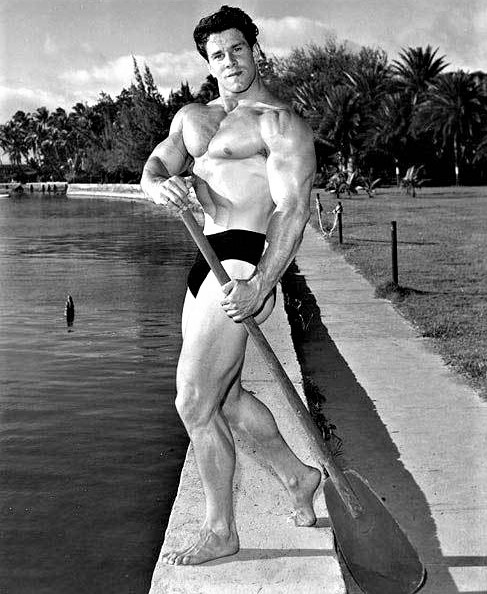Hafþór Júlíus Björnsson, 2017 Arnold Strongman Classic / Paula R. Lively
5×5 is most associated with strength training today. 5×5 programs were popularized by weightlifter and strength coach Bill Starr in his 1976 book The Strongest Shall Survive, which has influenced generations of strength athletes and coaches. However, the concept of workouts with five sets of five reps can be traced to legendary bodybuilder Reg Park back in the 1950s, who was much more concerned about muscle growth than strength gains.
We don’t discriminate at The Barbell. So, we’re going to analyze both Reg Park’s 5×5 bodybuilding program and Bill Starr’s 5×5 strength program. How are they similar and different? And, most importantly, whatever your goal, how can you best make five sets of five reps the foundation of your workouts?
First, though, why five sets of five reps? Of course, there’s nothing magical about five. And, as we’ll see, both programs do deviate a little from both five sets and five reps. But five sets of an exercise gives you enough volume each workout to truly focus on that movement; and five reps is in the power sweet spot, low enough for a strength-focus but high enough to progressively tack on another rep or a little more weight. 5×5 it is. Let’s explore how to best use 5×5 for bodybuilding and strength.
5×5 BODYBUILDING WORKOUT
Five sets of five reps probably dates back to the earliest days of weight-training. But, around 1950, British-born Reg Park (1928-2007)—3-time Mr. Universe, cinematic Hercules, and idol of young Arnold Schwarzenegger—developed a 5×5 system with three distinct phases, an emphasis on basic lifts, and (most) exercises performed for five sets of five reps.

Workouts consisted of only one or two exercises per bodypart, and some areas were neglected entirely. For example, both front and back squats were included in Park’s routine as well as deadlifts, all of which stress the lower body. However, there was no direct hamstring exercise. With its full-body emphasis and Olympic-style moves like high pulls and standing presses, Reg Park’s paradigm now more closely resembles a CrossFit routine than a modern bodybuilding workout. And there’s the novelty of beginning each workout with weighted back extensions (a.k.a. hyperextensions) for spinal erectors.
Nevertheless, the 1951 Mr. Universe set the parameters for every 5×5 system that followed: Focus on getting stronger in the most basic exercises by doing five sets of five reps. In the Park program, the first two of five sets are progressively heavier. Then the final three sets are with the same maximum weight, aiming for five reps each time.
So, if you can squat 315 lbs. for 5 reps, a progression goes like this:
| Set | Weight | Reps | % Max. |
|---|---|---|---|
| 1 | 205 lbs. | 5 | 65% |
| 2 | 275 lbs. | 5 | 85% |
| 3-5 | 315 lbs. | 5 | 100% |
When you can complete all of the final 3 sets of 5 reps at a given weight or get a 6th rep, increase the weight on all five sets 5-10 pounds in the next workout.
The three phases of Reg Park’s program each lasted three months. In each phase, perform the following workouts three times weekly, with at least one off-day between workouts (example: Monday, Wednesday, Friday). As you’ll see, the volume will really ramp up, from 20 sets per workout in phase 1 to 38-39 in phase 2 to lengthy 48-49 set totals in phase 3, and each of those workouts done thrice weekly. After completing phase 3, begin again with phase 1.
PHASE 1
Weighted Back Extension — 3 sets x 10 reps
Squat — 5 sets x 5 reps
Bench Press — 5 sets x 5 reps
Deadlift — 5 sets x 5 reps
PHASE 2
Weighted Back Extension — 3-4 set x 10 reps
Squat — 5 sets x 5 reps
Front Squat — 5 sets x 5 reps
Bench Press — 5 sets x 5 reps
Standing Shoulder Press — 5 sets x 5 reps
High Pull — 5 sets x 5 reps
Deadlift — 5 sets x 5 reps
Standing Calf Raise — 5 sets x 25 reps
PHASE 3
Weighted Back Extension — 3-4 sets x 10 reps
Squat — 5 sets x 5 reps
Front Squat — 5 sets x 5 reps
Bench Press — 5 sets x 5 reps
Barbell Row — 5 sets x 5 reps
Deadlift — 5 sets x 5 reps
Standing Shoulder Press — 5 sets x 5 reps
Barbell Curl — 5 sets x 5 reps
Lying Triceps Extension — 5 sets x 5 reps
Standing Calf Raise — 5 sets x 25 reps
Note: To make certain your hamstrings get some direct work, The Barbell recommends swapping in lying leg curls (5 sets x 10-12 reps) for either deadlifts or front squats in at least one weekly workout in phases 2 and 3.
5×5 STRENGTH WORKOUT
Hall of Fame strength coach Bill Starr (1938-2015) stripped the 5×5 program down to its basics with lower volume throughout but also focused more on incremental strength gains. He even included some Park-favored weighted back extensions. Typically, on Starr’s program, you do only three basic exercises per workout, such as squat, bench press, and deadlift. (Starr was big on power cleans for football players, but we’ve included the deadlift below. We’ve also replaced weighted sit-ups, a relic of another era, with machine crunches.)

Bill Starr’s intermediate program prescribes three weekly workouts—heavy, light, and medium—with one off-day between each and two at the end. (We’ve gone with Monday-Wednesday-Friday in our example with weekends off.) It looks like this:
Monday: Heavy Day
Squat — 5 sets x 5 reps
Bench Press — 5 sets x 5 reps
Deadlift — 5 sets x 5 reps
Weighted Back Extension — 2 sets x failure
Machine Crunch — 4 sets x failure
Wednesday: Light Day
Squat — 4 sets x 5 reps
Incline Bench Press — 4 sets x 5 reps
High Pull — 4 sets x 5 reps
Machine Crunch — 3 sets x failure
Friday: Medium Day
Squat — 4 sets x 5 reps, 1 set x 3 reps, 1 set x 8 reps
Bench Press — 4 sets x 5 reps, 1 set x 3 reps, 1 set x 8 reps
Deadlift — 4 sets x 5 reps, 1 set x 3 reps
Weighted Dip — 3 sets x 5-8 reps
Lying Triceps Extension — 3 sets x 8 reps
Barbell Curl — 3 sets x 8 reps
The middle workout is a bit of a coasting workout, not approaching failure on the major lifts and swapping in incline presses and high pulls. The first and third weekly workouts are paired. Each of the five sets per powerlift on Monday increase in weight from set to set up to the final maximum set of 5 reps. On Friday, each three-rep powerlift set is performed with approximately 2.5% more weight than the maximum 5-rep set on Monday. Then the following Monday, use the same weight for 5 reps in powerlift apex sets that you used for 3 reps on Friday.
So, a progression over three weeks looks like this:
| Day | Apex Set Reps | Max Weight |
|---|---|---|
| Monday | 5 | 200 lbs. |
| Friday | 3 | 205 lbs. |
| Monday | 5 | 205 lbs. |
| Friday | 3 | 210 lbs. |
| Monday | 5 | 210 lbs. |
| Friday | 3 | 215 lbs. |
In this way, you accustom your mind and body to using a heavier weight on Friday, though for an easy 3 reps. Then you use that same weight on Monday, but push yourself to a maximum 5 reps. The goal is to gain 2.5% per week.
Bill Starr recommended easing your way into the program by starting your progression with a weight that’s about 7.5% below your max. So, if 200 lbs. for 5 reps is your starting max, begin with 185 lbs. Then advance so you’re at your max (in this case, 200 lbs.) at week 4 and then keep increasing the weights by approximately 2.5% per week whenever possible.
So, using the same 200 lbs. max starting weight, an ideal 12-week strength progression looks like this:
| Week | Weight | Gain |
|---|---|---|
| 1 | 185 lbs. | |
| 2 | 190 lbs. | |
| 3 | 195 lbs. | |
| 4 | 200 lbs. | 0% |
| 5 | 205 lbs. | 2.5% |
| 6 | 210 lbs. | 5.06% |
| 7 | 215 lbs. | 7.69% |
| 8 | 220 lbs. | 10.38% |
| 9 | 225 lbs. | 13.14% |
| 10 | 230 lbs. | 15.97% |
| 11 | 235 lbs. | 18.87% |
| 12 | 240 lbs. | 21.84% |
A 22% gain in three months is superb. Consider it aspirational. The more experienced you are, the harder it will be to make such weekly improvements. If you fail to get 5 reps in any of your Monday apex sets, stick with that weight until you do. If you get 5 reps, increase the weight about 2.5% on Friday (for 3 reps) and use that same weight on Monday (for, hopefully, 5 reps). The powerlifts probably won’t improve at the same rate. But the 5×5 Bill Starr program has proven to be one of the most effective methods for progressively growing stronger.
5×5 WORKOUT CONCLUSION
The key to any 5×5 program, whether for bodybuilding or strength, is lifting heavy weights in the same basic exercises often and progressively—systematically increasing those heavy weights from week to week throughout the program. This is called the law of specificity, and it applies to pretty much any sport or pursuit. If you want to get stronger for low reps in the squat, for example, don’t fill your workout with higher-rep leg presses and leg extensions. Instead, do squats for low reps, lots of squats, and do them often and, whenever possible, with more weight.
5×5 has been around a long time. But unlike many weight-training practices from the 1950s or 1970s, it’s still going strong today. That’s because it still works, just as hard work always has. Whether done for bodybuilding or strength, routines constructed around five sets of five reps focus your workouts on basic exercises and progressive resistance—the essential building blocks for more muscle and more power.

















































